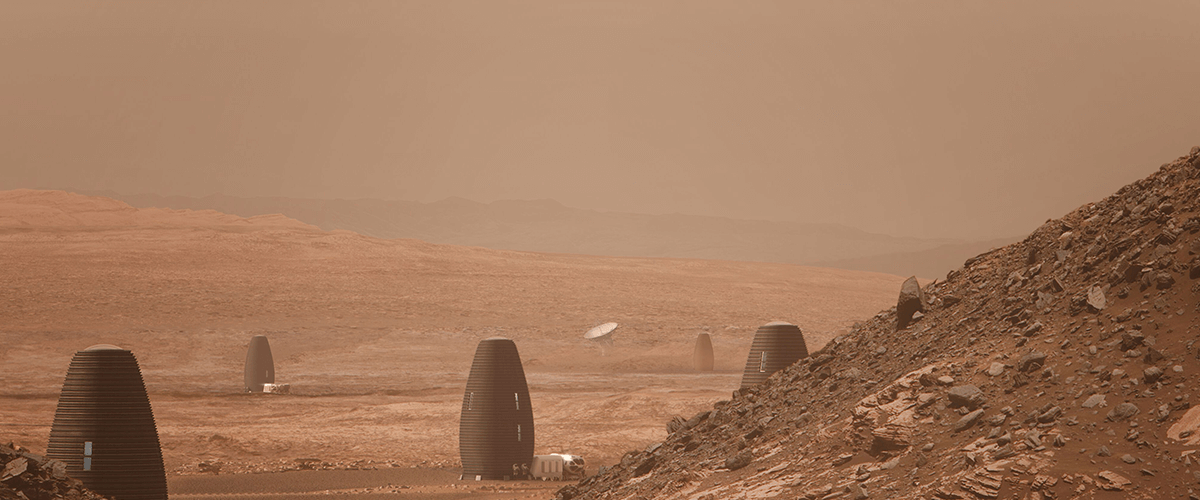AI SpaceFactory: the team building a Martian home, on Earth. What if I told you that you could spend the night in a Martian house? Whilst a manned trip to Mars might be a long way off yet, you will soon be able to stay the night in a prototype, extraterrestrial home.
TL;DR
AI SpaceFactory are building a Martian house on Earth...
The team are using the technology that won them first prize in the NASA 3D-Printed Habitat Challenge to build an eco-home on Earth (TERA). The Martian house is printed with a recyclable-biodegradable material that is over 50% stronger than concrete. You can stay the night and the team will use the data to improve their Martian design (MARSHA).
AI SpaceFactory recently won first prize in NASA's 3D-Printed Habitat Challenge, worth a cool $500,000 (€439,800), with their design MARSHA The team won the NASA 3D-Printed Habitat Challenge by successfully printing a ⅓ scale model, with nearly no human assistance, in around 30 hours. The windows and doors were prefabricated and robotically lifted into place.

3D printing the 1/3 scale model at the final stage of the NASA 3D-Printed Habitat Challenge. Image credit: AI SpaceFactory.
TERA
The Earthbound design, "TERA" uses the same technology as the NASA project, to create a Martian home on Earth. The company claims that TERA is the "first ever space tech eco-habitat on Earth". It's also one of the largest and most ambitious 3D printed building projects to date.

A little piece of Mars on Earth. Image credit: AI SpaceFactory and Plomp
TERA will be made from the recycled material that the team used to make their winning MARSHA prototype (basalt fiber-reinforced polylactic acid -- PLA). When NASA subjected this material to pressure, smoke, and impact testing, it was found to be at least 50% stronger than concrete! It also has one of the lowest thermal expansion and contraction rates of any known plastic and is one of the most effective insulators known to man. Maybe best of all? It's non-toxic. At the end of the building's life, this material can be composted. This space-age technology really has the potential to revolutionize the way we build.
We developed these technologies for Space, but they have the potential to transform the way we build on Earth. By using natural, biodegradable materials grown from crops, we could eliminate the building industry's massive waste of unrecyclable concrete and restore our planet. -- David Malott, CEO and Founder of AI SpaceFactory
Stay the Night
As early as September 2019, the team hope to make TERA available to stay in. It will take around 1 week to print, they say. It will be located in a nature area 2 hours train ride from New York, offering the perfect getaway. Become simultaneously immersed in the natural beauty of Earth, whilst experiencing a taste of life on another planet.

Image credit: AI SpaceFactory and Plomp
The MARSHA design has been adapted to better suit life on Earth. The terrestrial design will be slightly smaller than its Martian counterpart with 2 floors. It also benefits from more windows and a larger entrance as it does not need to be pressurized. They hope to use the data they collect on people's stay in the building to improve their extraterrestrial design.
MARSHA
building houses on Mars presents a great number of challenges. The thin atmosphere means that, during the summer, temperatures can vary wildly, around 20°C (70°F) during the day and -- 73°C (- 100°F) at night. This means that MARSHA needs to hold in the heat to allow humans to maintain a comfortable living environment, the structure must also allow for expansion and contraction, and the building must have the capacity to allow it to be pressurized and oxygen filled.
An Egg-shape was deemed to give the best living-space:energy-efficiency ratio. This shape is also the most stable when pressurized. Additionally, the shape reduces the surface area, which means using less material under less stress. A reduced volume means reduced energy loads and a reduced diameter reduces structural stresses. This is particularly true around the base of the structure. Additionally, a decrease in the diameter reduces the printer's required movement.
Material
Basalt fiber-reinforced polylactic acid, used for the prototype, can be made materials found on the surface of Mars. Basalt fiber could be extracted from nearby martian rock, whilst plants grown on Mars would provide the polylactic acid. No comments yet as to how the terraforming would be constructed to allow such plants to grow. Currently, the windows and doors would need to be pre-fabricated on Earth and then transported to Mars.

Image credit: AI SpaceFactory and Plomp
The base is printed from the outside in, this is because plastic shrinks after it has been printed. Printing in this manner produces a more predictable shrinkage pattern. At the base the Martian house will move on sliding bearings which reduces the contact with the ground. This protects the pins from the elements and still allows the building to expand and contract.
The layout
The interior has a double shell layer which separates the living space from the outer shell and stands at 13.7 m (45 ft) height and 7.3m (24 ft) in diameter. This also acts as a light well allowing a water-filled skylight to disperse light throughout the building.

Prototype model of the MARTIA design. Image credit: AI SpaceFactory.
The building contains 4 floors.
- The ground floor aka "the garage" forms the entrance and laboratories.
- The next level houses the kitchen and a "dry lab".
- The third level contains sleeping pods, the bathroom, and hydroponics -- beneficial for both food and oxygen.
- The fourth, final floor is reserved for recreational activities. This maximizes on the light provided.
Each level has at least one window and all face in different directions, maximizing the views available.

Hydroponics to grow food and produce oxygen. Image credit: AI SpaceFactory and Plomp
Mental health is the focus of the whole building design. The design provides them with an opportunity to relax and escape the stress and routine a manned mission to Mars would entail.

Sleeping pods provide space to relax and unwind during missions. Image credit: AI SpaceFactory and Plomp
Think you could design a Martian house?
Make the effortless move to BricsCAD BIM. Freedom of choice, plus perpetual (permanent) product licenses that work with all languages, in all places. You'll love what we've built for you with the BricsCAD® product family.
Disclaimer: All brand names and product names mentioned in this post are trademarks or service marks of their respective companies.
These links are being provided as a convenience and for informational purposes only; they do not constitute an endorsement or an approval by Bricsys of any of the products, services or opinions of the corporation or organization or individual. Bricsys bears no responsibility for the accuracy, legality or content of the external site or for that of subsequent links. Contact the external site for answers to questions regarding its content.


